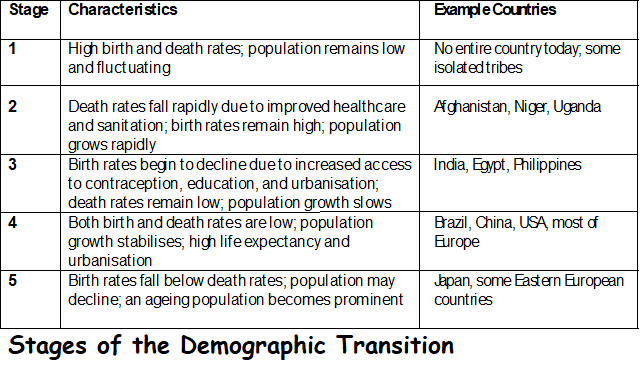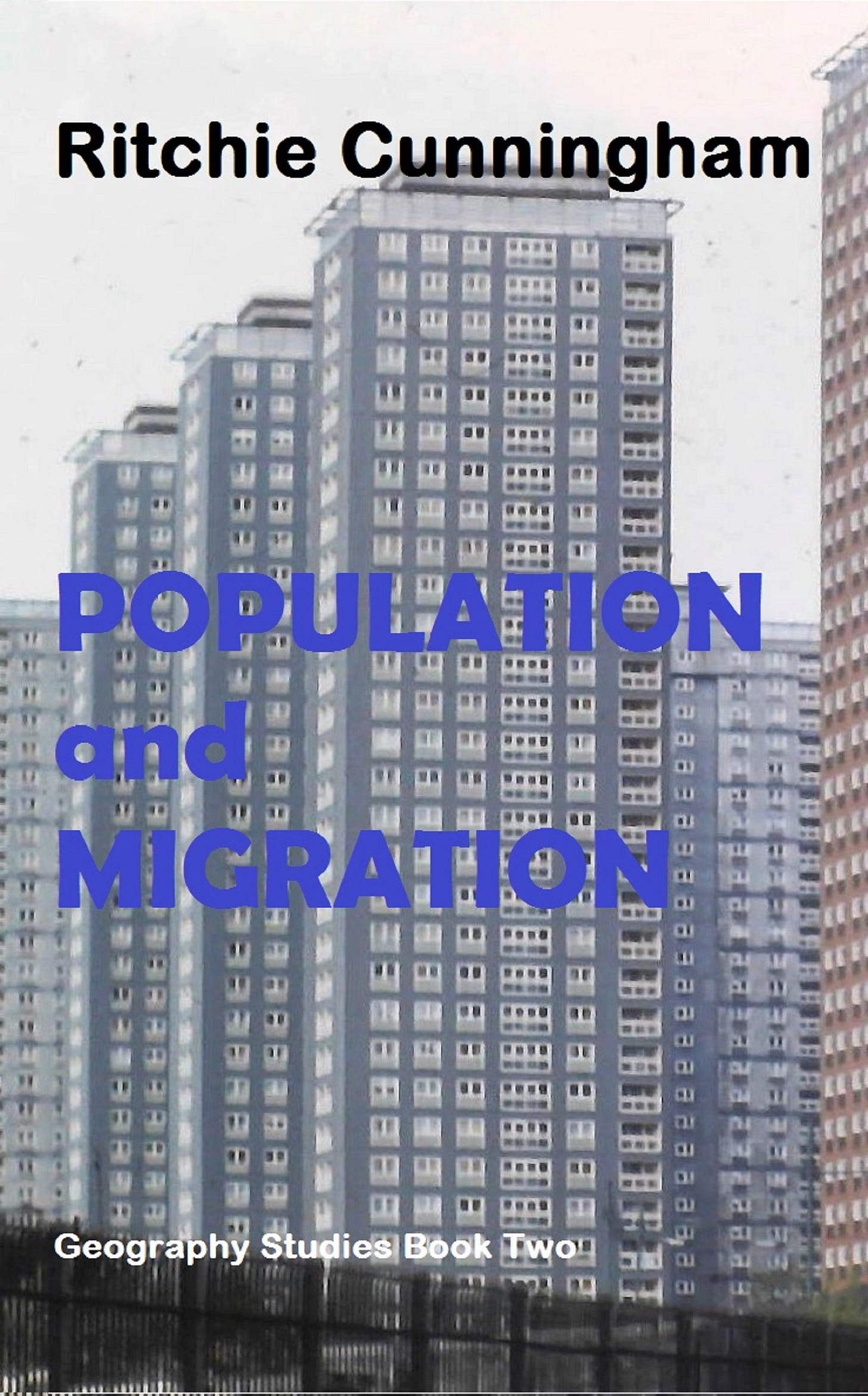The Demographic Transition Model (DTM) is a fundamental concept in population geography, illustrating how a country’s population structure changes as it develops economically and socially. The model is based on historical trends in birth and death rates and is divided into five distinct stages, each reflecting a different phase of demographic and economic development.
Stages of the Demographic Transition Model
Stage 1: Characterised by high birth and death rates due to limited medical knowledge, poor sanitation, and subsistence economies. Population growth is minimal.
Stage 2: Death rates drop sharply as a result of improved healthcare, nutrition, and sanitation, but birth rates remain high, leading to rapid population growth.
Stage 3: Birth rates start to decline, reflecting increased access to family planning, higher costs of raising children, and greater female participation in education and the workforce. The population continues to grow, but at a slower pace.
Stage 4: Both birth and death rates are low, resulting in a stable and high total population. This stage is associated with advanced economies, high levels of education, and widespread access to healthcare.
In recent years with more countries experiencing population decrease and an ageing population Stage 5 has been added to the original 4-stage DTM.
Stage 5: Birth rates fall below death rates, leading to a natural decrease in population and an increasingly ageing population.
A Developing Country in the Middle Stages: India
India is a prime example of a developing country currently in Stage 3 of the DTM. Here, death rates have significantly declined due to improvements in healthcare and sanitation, but birth rates, while falling, remain above replacement level. This results in continued but slowing population growth.
Social and Economic Problems Arising from India’s Population Structure
Youth Bulge: A large proportion of the population is under 25, putting pressure on the education system, job market, and housing.
Unemployment and Underemployment: The economy struggles to create enough jobs for the rapidly growing working-age population, leading to high youth unemployment.
Strain on Infrastructure: Rapid urbanisation and population growth stress transport, healthcare, and sanitation systems.
Resource Depletion: High population density increases competition for water, food, and energy.
Gender Inequality: Although improving, disparities in education and employment opportunities for women persist, affecting further reductions in birth rates.
India’s youth bulge
With over half the population under 25, this has profound impacts on the country’s social and economic stability during Stage 3 of the Demographic Transition Model.
Economic Impacts
Unemployment and Underemployment: The job market cannot keep pace with the millions entering the workforce each year. Surveys show that nearly 36% of young Indians (ages 15–34) cite unemployment as their top concern. Even graduates from elite institutions struggle to find suitable jobs, and underemployment is widespread, with many working in roles below their qualifications.
Skills Gap: Fewer than 17% of graduates are immediately employable, and only 2.3% of the workforce has formal skill training, compared to much higher rates in countries like Japan and South Korea. This mismatch between education and market needs exacerbates joblessness and economic frustration.
Rising Costs and Debt: The soaring cost of higher education saddles young adults with debt, while many families must make significant financial sacrifices to afford education and healthcare. The return on investment for education is often low, with many graduates unable to secure jobs that justify their expenses.
Poverty and Inequality: Economic growth has not translated into equitable opportunities. Many young people, especially from rural or marginalized backgrounds, remain excluded from quality education and formal employment, deepening socioeconomic divides.
Social Impacts
Mental Health Strains: High unemployment, academic pressure, and job insecurity contribute to widespread mental health issues among youth, including high rates of depression and suicide.
Social Unrest: The gap between aspirations and opportunities is fueling frustration. The International Labour Organisation warns of a potential “scarred generation,” with protests and riots already occurring over job quotas and economic grievances.
Urban-Rural Divide: While urban youth may have greater access to information and opportunities, most of India’s youth still live in rural areas, where life remains unchanged and aspirations are increasingly unmet.
Structural Challenges
Demographic Momentum: As India moves through Stage 3, the large cohort of young people creates both a potential demographic dividend and a risk of instability if their needs are unmet. The uneven transition across states and socioeconomic groups complicates policy responses.
Education-Employment Disconnect: Education is not adequately aligned with job market requirements, leaving many graduates unprepared for available jobs.
Risks to Stability
Protests and Political Pressure: Growing frustration among youth can destabilize society, as seen in recent protests over employment and reservation policies.
Delayed Demographic Dividend: Without significant investment in education, skills, and job creation, the potential economic benefits of the youth bulge may not materialize, and instead, India risks increased poverty, inequality, and social unrest.
India’s youth bulge, if not addressed through comprehensive reforms in education, skills development, and job creation, poses significant challenges to its social cohesion and economic future during this critical stage of demographic transition.
Difficulties in Transitioning from Stage 3 to Stage 4
Countries moving from Stage 3 to Stage 4 face several challenges:
Cultural Resistance: Traditional values may favour larger families, slowing the decline in birth rates.
Economic Barriers: Inadequate investment in education, healthcare, and women’s empowerment can impede progress.
Urban-Rural Divide: Rural areas may lag in access to family planning and education, maintaining higher birth rates.
Social Security Concerns: In the absence of robust pension systems, families may continue to have more children as a form of old-age security.
Youth Unemployment: If job creation does not keep pace with the growing labour force, social unrest and economic stagnation can result.
Suitable Geography Examination Questions
Describe the stages of the Demographic Transition Model and explain how birth and death rates change at each stage.
Using a named example, discuss the social and economic challenges faced by a country in Stage 3 of the DTM.
Explain why some countries find it difficult to transition from Stage 3 to Stage 4 of the Demographic Transition Model.
Evaluate the usefulness and limitations of the Demographic Transition Model in explaining global population trends.
How might government policies help a country progress from Stage 3 to Stage 4 of the Demographic Transition Model?
These questions encourage students to apply their understanding of the DTM, analyse real-world examples, and consider the broader implications of demographic change





